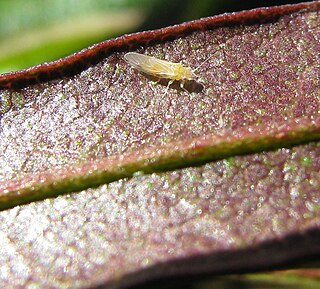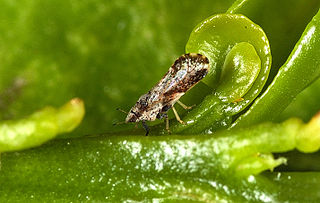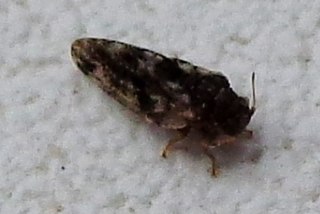
Hemiptera is an order of insects, commonly called true bugs, comprising over 80,000 species within groups such as the cicadas, aphids, planthoppers, leafhoppers, assassin bugs, bed bugs, and shield bugs. They range in size from 1 mm (0.04 in) to around 15 cm (6 in), and share a common arrangement of piercing-sucking mouthparts. The name "true bugs" is often limited to the suborder Heteroptera.

The Pentatomoidea are a superfamily of insects in the Heteroptera suborder of the Hemiptera order. As Hemiptera, they share a common arrangement of sucking mouthparts. The roughly 7000 species under Pentatomoidea are divided into 21 families. Among these are the stink bugs and shield bugs, jewel bugs, giant shield bugs, and burrower bugs.

Psyllidae, the jumping plant lice or psyllids, are a family of small plant-feeding insects that tend to be very host-specific, i.e. each plant-louse species only feeds on one plant species (monophagous) or feeds on a few closely related plants (oligophagous). Together with aphids, phylloxerans, scale insects and whiteflies, they form the group called Sternorrhyncha, which is considered to be the most "primitive" group within the true bugs (Hemiptera). They have traditionally been considered a single family, Psyllidae, but recent classifications divide the group into a total of seven families; the present restricted definition still includes more than 70 genera in the Psyllidae. Psyllid fossils have been found from the Early Permian before the flowering plants evolved. The explosive diversification of the flowering plants in the Cretaceous was paralleled by a massive diversification of associated insects, and many of the morphological and metabolic characters that the flowering plants exhibit may have evolved as defenses against herbivorous insects.

In biology, a lerp is a structure of crystallized honeydew produced by larvae of psyllid bugs as a protective cover. These animals are commonly referred to as lerp insects, of which there are over 300 species in Australia.

Zebra chip, also known as papa manchada and papa rayada, is a disease in potatoes putatively caused by an alphaproteobacterium "Candidatus Liberibacter solanacearum", which is vectored by the potato psyllid. When fried, potato tubers from infected plants develop unsightly black lines resembling the stripes of zebras that render the chips unsellable. Additionally, striped sections of chips frequently burn and caramelize, resulting in a bitter flavor. No health risks have been connected with consumption of infected potato chips.

Acizzia dodonaeae is a psyllid common on Dodonaea viscosa.

Acizzia is a genus of psyllids that primarily feed on Acacia and Albizia species. Many species are known from Australia and have become widespread as their host plants are popular garden specimens. Damage to the leaves is generally mild. Economic damage on plantation species is occasionally reported.

Acizzia uncatoides is a species of psyllid native to Australia where it feeds primarily on Acacia and some Albizia species. It is present in many parts of the world where it infests these plant species, presumably introduced with the plants. It is not generally regarded as a pest species although it can proliferate to high numbers. Generalist psyllid predators also feed on this species.

Acizzia acaciaebaileyanae is a psyllid common on Acacia baileyana, a popular garden specimen. They have also been associated with Acacia podalyriifolia. The psyllid and its host plant are native to Australia, but both are now widespread where the plant has been introduced including New Zealand, South Africa, Italy, and California, USA. The psyllid can reproduce to very high numbers, but appears not to damage the plant.

Triozidae is one of seven families collectively referred to as jumping plant lice. They have traditionally been considered part of a single family, Psyllidae, but recent classifications divide the group into a total of seven families; most of the genera remain in the Psyllidae, but Triozidae is the second-largest family in the group, containing 27 genera, and a number of pest species.
Aacanthocnema is a genus of bugs from the jumping plant lice family (Triozidae). The genus is endemic to Australia, and currently contains six species, found in all states and territories with the exception of the Northern Territory.

Gargaphia solani is a subsocial species of lace bug commonly known as the eggplant lace bug. The species was described by Heidemann in 1914 after it aroused attention a year earlier in the United States as an eggplant pest around Norfolk, Virginia. Fink found that the species became an agricultural pest when eggplant is planted on a large scale.

Diaphorina citri, the Asian citrus psyllid, is a sap-sucking, hemipteran bug in the family Psyllidae. It is one of two confirmed vectors of citrus greening disease. It has a wide distribution in southern Asia and has spread to other citrus growing regions.

Liberibacter is a genus of Gram-negative bacteria in the Rhizobiaceae family. Detection of the liberibacteria is based on PCR amplification of their 16S rRNA gene with specific primers. Members of the genus are plant pathogens mostly transmitted by psyllids. The genus was originally spelled Liberobacter.

Psylla is a genus of sap-sucking insects belonging to the order Hemiptera. There are at least 110 described species in Psylla. Species within the genus feed on various host plants.

Cardiaspina fiscella, the brown basket lerp or brown lace lerp, is a jumping plant louse species in the genus Cardiaspina originally found in Australia. It spread to New Zealand where it was found in 1996 near the Auckland airport. It feeds on eucalyptus, especially swamp mahogany, and is found in Victoria, eastern New South Wales, and southeastern Queensland, as well as the capital territory (ACT) around Canberra and on Norfolk Island. Cardiaspina fiscella has five nymphal instars, and as the instars moult they add a layer to their outside covering (casing), known as the "lerp".

Aphalarini is a tribe of jumping plant lice (psyllid) in the subfamily Aphalarinae, first described by Franz Löw in 1879.

Tamarixia radiata, the Asian citrus cyllid parasitoid, is an hymenopteran wasp from the family Eulophidae which was discovered in the 1920s in the area of northwestern India (Punjab), now Pakistan. It is a parasitoid of the Asian citrus psyllid, an economically important pest of citrus crops around the world and a vector for Citrus greening disease.

Trioza adventicia, commonly known as the syzygium leaf psyllid, lillypilly psyllid, or eugenia psyllid, is a sap-sucking hemipteran bug in the family Triozidae which creates galls on the leaves of Syzygium paniculatum. This species is native to eastern Australia and has been introduced into California, southern Australia, and New Zealand.

Psylla frodobagginsi or the hobbit kōwhai psyllid is a species of psyllid, a plant-feeding hemipteran in the family Psyllidae. It is endemic to New Zealand and is found only on New Zealand kōwhai trees and is named after the character Frodo Baggins from The Lord of the Rings.


















